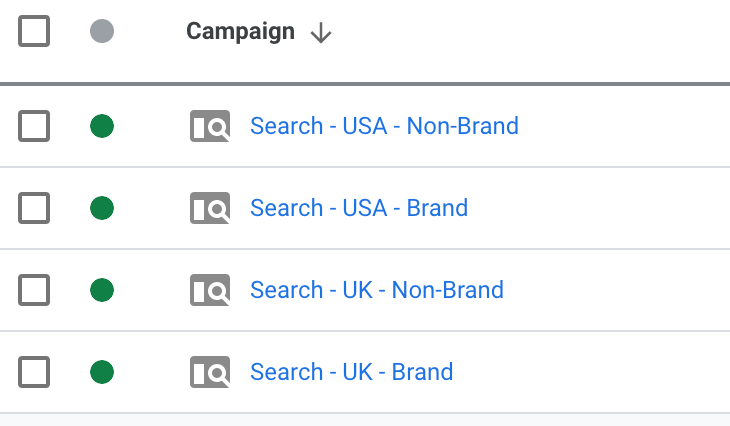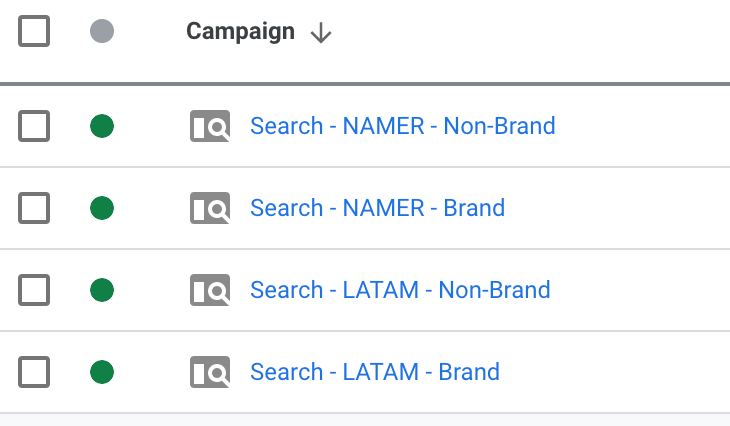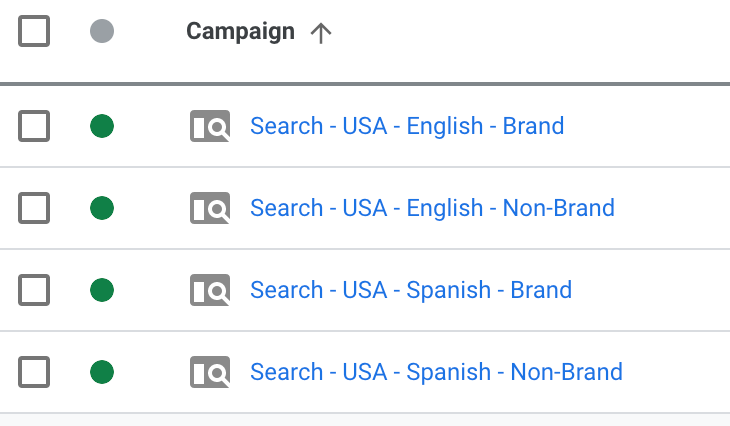Table of Contents
Google Ads is an excellent tool for international marketing, as it allows businesses to reach a large, targeted audience in various countries across the globe.
However, it can be challenging to create and manage multiple campaigns targeting different countries and languages. At Go Fish Digital, we have worked with many clients advertising their products or services in various countries and regions, and we have identified four campaign structures that have proven to be effective for international Google Ads campaigns.
Related Content:
There is not one magical way to structure your account, as each company and industry is unique, but by following one of these structures, you can effectively market your products or services in different countries and regions using Google Ads.
- Separate campaigns for each country
- Separate campaigns per region
- Separate campaigns for each language
- Hybrid approach
Below you can find more information about each one.
1. Separate campaigns for each country
In this approach, you create a separate campaign for each country you are targeting. This allows you to fully customize your targeting, ad copy, and other campaign elements to match the specific needs and preferences of each market. This can help to improve the performance of your campaigns and drive better results. You can also set different budgets for each market, which can be useful if certain markets require more investment than others.
Example of campaign structure with separate campaigns for each country:
- Search – USA – Non-Brand
- Search – UK – Non-Brand
- Search – USA – Brand
- Search – UK – Brand
This approach allows you to tailor your targeting and bidding to each country, but it may require more effort to manage multiple campaigns for different countries.
2. Separate campaigns per region
In this approach, you create campaigns targeting several countries from the same region. This allows you to consolidate your targeting and bidding to larger areas.
Examples of common regions include NAMER (North America), EMEA (Europe, Middle-East, Africa), DACH (Germany, Austria, Switzerland), and LATAM (Latin America). You can also group countries however it makes the most sense for your business and choose to target only specific countries from a region.
These groupings will work well for your business if your products or services are the same in certain regions, or if you target a region where people have similar languages, cultures, and currencies.
Example of campaign structure with separate campaigns for each region:
- Search – NAMER – Non-Brand
- Search – LATAM – Non-Brand
- Search – NAMER – Brand
- Search – LATAM – Brand
It allows you to target a larger audience with fewer campaigns, which can help to streamline your campaign management, making it easier to track performance, set budgets, and make adjustments.
However, this method allows for less flexibility for targeting specific countries within the regions. A major downside is that you will lose control of how your campaign’s budget is allocated between countries. For example, if one of the countries overperforms against the others, it is likely that the Google algorithms will start prioritizing it and allocate most of the budget toward this one country, leaving the other countries in the same campaign with a limited budget.
Another inconvenience of this approach is that you should run ads in only one language per campaign. For targeting regions with many languages, such as Europe, this approach doesn’t allow you to optimize your campaigns with the language of each country.
3. Separate campaigns for each language
In the language-specific approach, you create a separate campaign for each language you are targeting. This allows you to tailor your ad copy, keywords, and targeting options to the specific language and cultural preferences of each target audience. This approach can be effective if you are targeting multiple languages and want to ensure that your campaigns are optimized for each one of them.
By using local languages, you can remove the barrier of language and allow people to easily understand the ad and its message. You can ensure that your ads are more relevant to your target audience, as they will be able to understand the language and context of the ad, which is likely to lead to higher engagement and conversion rates. Using local languages can also help to build trust with your target audience, as it shows that your business is willing to make an effort to communicate with them in a language that they are comfortable with.
Example of campaign structure with separate campaigns for each language:
- Search – USA – English – Non-Brand
- Search – USA – Spanish – Non-Brand
- Search – USA – English – Brand
- Search – USA – Spanish – Brand
This approach allows you to tailor your ad copy and targeting to each language, but it can be more time-consuming to manage multiple campaigns in different languages. Managing multiple campaigns in different languages might require coordinating with different teams or translators and keeping track of multiple ad groups and campaigns.
Make sure to consider the following items when running international Google Ads campaigns in different languages:
- Keyword research: Conducting keyword research in a different language can be time-consuming and may require the use of language-specific tools or the help of native speakers.
- Translating ad copy: Translating ad copy accurately and effectively can be challenging, as it requires a thorough understanding of the language, culture, and context in which the ad will be displayed.
- Translating landing pages: Similar to ad copy, translating landing pages can be an arduous process, and might require the help of native speakers or professional translators. Translations need to be accurate to establish trust and credibility with potential customers.
- Cultural differences: It’s important to consider cultural differences when running ads in different countries, as what works in one country may not work in another. For example, certain colors or imagery may have different connotations in different cultures.
4. Hybrid approach
The hybrid approach combines elements of the above methods to create a customized campaign structure that meets your specific needs. For instance, you can combine targeting by country or region with language targeting to create a campaign structure that is tailored to your business needs. This approach allows you to tailor your campaigns to specific markets and target audience demographics, ensuring that you are reaching the right people with the right message using the right language.
Example of campaign structure with separate campaigns for a hybrid approach:
- Search – NAMER – English – Non-Brand
- Search – NAMER – Spanish – Non-Brand
- Search – LATAM – Spanish – Non-Brand
- Search – LATAM – Portuguese – Non-Brand
Make sure to use a clear and organized naming convention for your campaigns and ad groups, so you can easily keep track of regions, countries, and languages targeted in your campaigns.
Conclusion
Ultimately, the best campaign structure for your international Google Ads campaigns will depend on your business goals, budget, and the level of control you want over your targeting and bidding.
Your business goals will help to determine the type of campaign structure that will be most effective for your business. For example, if your goal is to reach a broad audience in multiple countries, a campaign structure that is based on countries or regions may be most appropriate. On the other hand, if you want to target specific languages or cultural groups, a language-specific or hybrid approach may be more suitable. Not sure where to start? Reach out to the Go Fish Digital Paid Media team and we can help!
Search News Straight To Your Inbox
*Required
Join thousands of marketers to get the best search news in under 5 minutes. Get resources, tips and more with The Splash newsletter:



